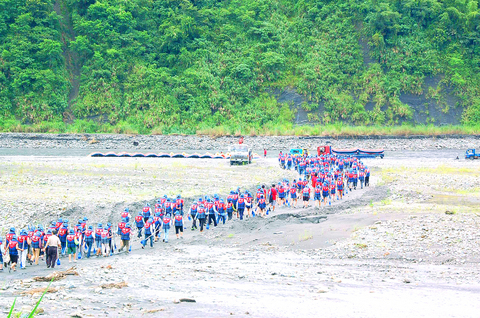To the workers and staff who were involved in the construction of the 12.9km-long Hsuehshan Tunnel, June 16, 2006 -- the day the tunnel opened -- is probably a day they will never forget.
On that day, they proved to themselves, the nation and the world that, after 15 years of work -- and a series of disasters that at one point almost halted the project -- they had accomplished an impossible mission. It was also a day that marked the official opening of the Chiang Wei-shui Freeway, which facilitates travel between Taipei and Ilan counties.
While media coverage over the past few days has focused on the eagerness of motorists nationwide to be among the first through the tunnel, those involved in building it reminded the public how the project began, and most importantly, the hardships workers experienced in completing the challenging task.

PHOTO: CHIU HSIEN-MING, TAIPEI TIMES
The project, which lasted through seven premiers and 10 transportation ministers, began with a vision.
During the 15 years it took to drill 12.9km through a mountain, the ground collapsed 98 times, underground water inundated the tunnel 36 times, tunnel boring machines were trapped inside 26 times and 25 workers lost their lives.
In the late 1980s, the Ministry of Transportation and Communications had already planned the Nangang-Pinglin section of the Taipei-Ilan Expressway, and officials proposed several options to connect Pinglin in Taipei County and the Ilan County.
Ou Chin-der (
Boring machines
Construction began in 1991, and tunnel-boring machines were purchased -- under the advisement of overseas experts -- to start drilling through the mountain.
But this decision led to a series of disasters.
The main reason, engineers recalled, was the failure to detect a massive aquitard -- a pocket of water captured in impermeable rock -- that had formed inside a sandstone layer millions of years ago.
When the machines hit the layer, water burst out and flooded the tunnel.
Winson Chang (
Now in his early forties, Chang said the real frustration began when one of the boring machines got stuck in the pilot tunnel in 1993.
According to Chang, construction difficulties continued over the following four years.
The most unforgettable disaster was a ground collapse in 1997, which damaged approximately 100m of tunnel that was already built and caused landslides that moved 10,000m3 of rubble, and buried a boring machine. The manufacturer estimated that fixing the machine would cost twice as much as buying a new one and that repairing it would take an additional 38 months.
After that, RSEA Engineering Corp, the contractor recruited for the construction, decided to forfeit the tunnel boring machines and adopt a drilling and blasting method instead. The risks involved in doing so drove away many potential overseas contractors, who all failed to find insurance companies willing to cover the occupational hazards.
The withdrawal of overseas contractors shook the confidence of the ministry, and at one point it thought about abandoning the tunnel project completely.
An alternative was put on the table: straightening the existing Taipei-Ilan Highway which meanders through the mountains by constructing an overpass. That option could have become reality if it were not for the persistence of former bureau director Cheng Wen-long (鄭文隆), who persuaded the Minister of Transportations and Communications to continue the project.
New freeway
The completed tunnel has also brought into full operation the Chiang Wei-shui Freeway, which is expected to affect the development of the nation's northeastern region.
As the commuting time between Taipei and Ilan has now been cut to around 30 minutes, motorists can now bypass Pinglin. They can also choose not to take the longer scenic drive along the coastline highway. Media reports have shown that businesses along these routes have witnessed a significant reduction in customers over the past few days.
Huang Chi-liang (
"[The hotel industry] now ought to worry about how they are going to keep people here," Huang said, adding that tourists will expect more from travel service providers.
Huang said that the launch of the freeway would incorporate Ilan into the Taipei Metropolitan Area.
He added, however, that is was difficult to predict whether this would motivate more former Ilan residents to move back to their hometown.
Exploitation
Environmental protection groups have expressed concerns over the unrestricted exploitation of the land.
Lim Hak-yan (
This will devastate the environment to the point there is no way to redeem it, he said.
Lim also said that Taiwan cannot afford to build another highway.
Instead, the government should focus more on constructing public transportation systems, he said.
While most former Ilan County residents say they will enjoy the convenience the freeway brings, few expressed interest in returning and settling down for good.
Wu li-ming (
She said that while she was thrilled at the thought of arriving home in less than an hour, she was not particularly interested in moving back.
"A lot of young people have moved out of [Lotung] because there are not many jobs available," Wu said, "Ilan has beautiful scenery, but the salaries are too low to live on."

‘DENIAL DEFENSE’: The US would increase its military presence with uncrewed ships, and submarines, while boosting defense in the Indo-Pacific, a Pete Hegseth memo said The US is reorienting its military strategy to focus primarily on deterring a potential Chinese invasion of Taiwan, a memo signed by US Secretary of Defense Pete Hegseth showed. The memo also called on Taiwan to increase its defense spending. The document, known as the “Interim National Defense Strategic Guidance,” was distributed this month and detailed the national defense plans of US President Donald Trump’s administration, an article in the Washington Post said on Saturday. It outlines how the US can prepare for a potential war with China and defend itself from threats in the “near abroad,” including Greenland and the Panama

A magnitude 4.9 earthquake struck off Tainan at 11:47am today, the Central Weather Administration (CWA) said. The hypocenter was 32.3km northeast of Tainan City Hall at a depth of 7.3km, CWA data showed. The intensity of the quake, which gauges the actual effect of a seismic event, measured 4 in Tainan and Chiayi County on Taiwan's seven-tier intensity scale, the data showed. The quake had an intensity of 3 in Chiayi City and County, and Yunlin County, while it was measured as 2 in Kaohsiung, Nantou County, Changhua County, Taitung County and offshore Penghu County, the data showed. There were no immediate reports of

The Chinese Nationalist Party (KMT) is maintaining close ties with Beijing, the Democratic Progressive Party (DPP) said yesterday, hours after a new round of Chinese military drills in the Taiwan Strait began. Political parties in a democracy have a responsibility to be loyal to the nation and defend its sovereignty, DPP spokesman Justin Wu (吳崢) told a news conference in Taipei. His comments came hours after Beijing announced via Chinese state media that the Chinese People’s Liberation Army’s Eastern Theater Command was holding large-scale drills simulating a multi-pronged attack on Taiwan. Contrary to the KMT’s claims that it is staunchly anti-communist, KMT Deputy

RESPONSE: The government would investigate incidents of Taiwanese entertainers in China promoting CCP propaganda online in contravention of the law, the source said Taiwanese entertainers living in China who are found to have contravened cross-strait regulations or collaborated with the Chinese Communist Party (CCP) could be subject to fines, a source said on Sunday. Several Taiwanese entertainers have posted on the social media platform Sina Weibo saying that Taiwan “must be returned” to China, and sharing news articles from Chinese state media. In response, the Mainland Affairs Council (MAC) has asked the Ministry of Culture to investigate whether the entertainers had contravened any laws, and asked for them to be questioned upon their return to Taiwan, an official familiar with the matter said. To curb repeated